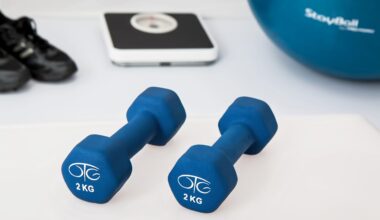CrossFit Training Journal Tips: Monitoring Strength Gains Effectively
Monitoring your strength gains is a key part of any CrossFit training regime. Keeping a detailed training journal can significantly improve your performance. In this journal, you should include the type of workout, the weights lifted, repetitions performed, and any notes about technique. Logging this information allows you to track your progress over time and helps you identify patterns. Effective journaling not only serves as a motivational tool but also aids in planning future workouts. By reflecting on past workouts and outcomes, you can adjust your training strategy, leading to better results. Use apps or traditional notebooks for this purpose, whichever feels manageable. Record your personal records (PRs) and re-evaluate them regularly to stay engaged. Monitoring your strength gains actively cultivates awareness around your performance levels, enhancing your experience. Remember, consistent results emerge from consistent efforts; hence, diligent logging fosters accountability. By focusing on your strength efforts, you can identify weak points in your training that require extra attention. After all, every small gain counts. Ensure to update your journal frequently to establish a clear picture of your journey toward strength excellence.
As you continue to track your progress, it’s important to note specific metrics. Metrics can include set limitations, maximal lifts, metabolic conditioning speeds, and recovery times. Additionally, documenting the types of movements performed can highlight your strengths and weaknesses. Comparing these metrics over time can provide you insights into areas that need improvement. For example, if you notice stagnant numbers in your deadlift, it might indicate a need to adjust your technique or training frequency. Always aim to challenge your body by varying weights and the number of repetitions. Setting specific goals for these metrics can help maintain motivation and focus in your workouts. Consider doing monthly assessments to review your performance comprehensively. Write a reflection in your journal to understand better your experiences during each workout. This habit results in self-awareness that is vital for your growth. Moreover, remember to celebrate small victories documented in your journal. Recognize and appreciate your effort to validate your journey. Setting new benchmarks encourages continuous growth and progression toward your fitness aspirations. Tracking metrics can be vital in maximizing your potential in CrossFit training.
Understanding the bigger picture of your training is fundamental for growth. CrossFit is about balancing strength, endurance, and skill, making it essential to not focus solely on weight lifting. Include notes on your aerobic conditioning exercises alongside strength training. This will provide you a balanced view of your overall fitness. Documenting how you feel during each workout can also guide your journey effectively. For instance, record your energy levels before and after your workouts for an accurate reflection. When you include your emotional states, it becomes easier to diagnose the factors affecting your performance. Moreover, consider documenting your nutrition strategies in your training journal as well. Nutrition is a vital piece of the CrossFit puzzle that influences your strength performance and recovery. Tracking your daily intake, hydration levels, and how you felt during workouts regarding the food you’ve consumed before can offer key insights. Using your training journal as a complete wellness diary positively impacts your training regimen. Thorough documentation aids in pinpointing what contributes to optimal performance in weight lifting and metabolic workouts. Ultimately, a comprehensive journal proves beneficial in the pursuit of CrossFit mastery.
Utilizing Feedback for Continuous Improvement
Feedback is crucial in optimizing your training outcomes. Discussing your experiences with coaches and peers can offer beneficial insights that enhance your strategy. By sharing your journal entries with your coach, you can gain an outside perspective. Coaches often spot areas for improvement that you may overlook. Furthermore, getting feedback from fellow athletes can be equally insightful; they may highlight techniques or methods that worked for them. Also, consider participating in community discussions or forums about CrossFit. These platforms can offer fresh perspectives that positively shape your routine. Engaging actively in community learning enriches your training experiences. Feedback mechanisms, both verbal and documented, help create a clearer pathway toward growth. Additionally, relying solely on numerical data might not provide a complete narrative about your performance. Integrate qualitative feedback into your journal, such as how a workout made you feel, to build a holistic view. By blending subjective experiences with objective data, you can develop informed strategies for your next workouts. Regularly revisiting your journal for feedback and insights creates a cycle of continuous improvement, bringing you closer to your strength goals.
Incorporating variety into your training sessions ensures well-rounded development. To monitor strength gains effectively, it’s important to change your workout routines regularly. Variation prevents plateaus, keeping both the body and mind stimulated. Record different exercises you incorporate into your training; this variety can maintain enthusiasm while enhancing overall fitness. Use your journal to document new movements and what you learn about them. Each workout session offers unique opportunities to grow stronger if approached with curiosity. Exploring different workout styles, such as Olympic lifting, gymnastics, or endurance work, diversifies your training experience. Make note of the changes in how certain workouts affect your body. For instance, you may find your squat increases when you modify assistance exercises or tweak your muscle-up technique. Be intentional about tracking these alterations to better understand your body and its responses. Keeping an organized journal of these variations will help you make connections between workouts and performance gains effectively. Over time, you will see the benefits of embracing change rather than relying strictly on a regular routine. Ultimately, variety supports comprehensive fitness improvements in your CrossFit journey.
Setting Specific Goals to Enhance Focus
Goal-setting, alongside journal documentation, sharpens your training focus and purpose. Defining what you want to achieve helps tailor your workouts to meet those targets effectively. Begin by identifying your long-term objectives, such as hitting a target weight for major lifts or mastering a certain skill. Break these down into smaller, achievable benchmarks to keep motivation levels high. For instance, if your goal is to increase your clean and jerk, determine specific weight increments to aim for weekly. Subsequently, record these goals in your journal to track progress diligently. Regular reflections on these goals provide clarity around your training’s timeline, ultimately shaping your workouts. Each week, assess your achievements concerning your goals and adjust them as necessary. This level of self-assessment fosters responsibility in your training and enhances your focus. Consider setting short-term goals that keep your engagement level high and propel you towards your larger aspirations. Goals act as a guiding light on your CrossFit journey, transforming vague intentions into clear action plans. Consistent documentation of these goals ensures that you stay on track, paving the way for continuous personal development.
Recovery plays a significant role in achieving your strength gains. Including recovery strategies in your training journal is beneficial for your overall performance. Track your rest days and the recovery techniques you employ, such as stretching routines or foam rolling sessions. Acknowledging how these recovery practices impact your performance helps in understanding their significance over time. For example, you may notice improved performance after actively promoting recovery between workout cycles. Documenting this can help you create an efficient recovery routine that suits your needs. Additionally, make use of journal entries to reflect on sleep quality and nutrition choices during your recovery phase. Quality sleep and proper nutrition contribute immensely to muscle recovery and strength adaptations. With this, you can highlight correlations between certain recovery habits and your energy levels in subsequent workouts. Maintaining a balance between intense training, rest, and recovery can help you reach your fitness goals faster. Lastly, do not overlook the importance of mental recovery, as it contributes to broader performance benefits. By thoroughly documenting every aspect of recovery, you can create a roadmap for optimal wellness within your CrossFit regimen.
As you actively engage with your training journal, it becomes a historical record of your progress. Reflecting on this journey allows you to appreciate how far you have come in strength gains, endurance, and technique. Revisiting past entries can reignite motivation and provide a sense of progress over time. Share your journal with fellow athletes or a coach periodically for community support. Knowing others are aware of your journey can hold you accountable and encourage you further. Holding the commitment to your journal helps you cultivate discipline within your CrossFit practice. Remember to approach it with an open mind; some days will be more productive than others. Consistency in journal writing allows you to celebrate all your workouts, leading to a better understanding of your growth. Ultimately, creating a habit around this practice can establish a strong foundation for personal peak performance. Your training journal stands as a testament to your journey, chronicling each step you take towards increased strength. Embrace this tool for tracking, modifying, and celebrating your CrossFit achievements. Commit to monitoring your progress actively, and watch yourself exceed your expectations in strength and performance.


